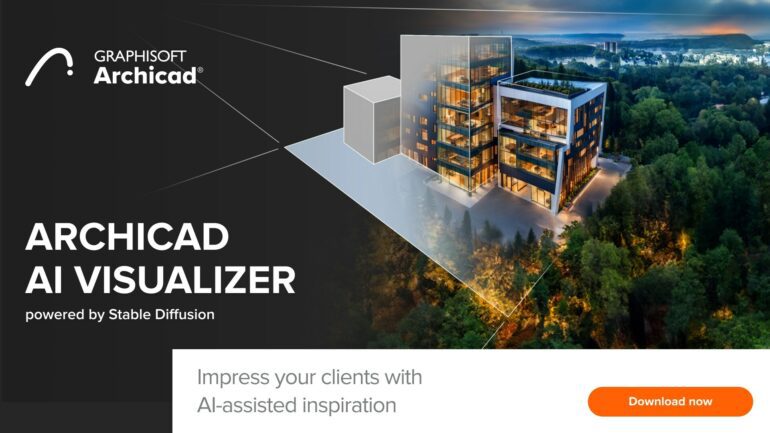TL;DR:
- Graphisoft introduces Archicad AI Visualizer for early-stage 3D visualizations in architecture.
- Powered by Stable Diffusion AI technology, it simplifies the design process.
- Adaptive Hybrid Framework enables swift integration of AI into Graphisoft’s solutions.
- AI enhances various aspects of Graphisoft’s operations, from support to localization.
- User feedback drives innovation, making AI accessible to architects and interior designers.
- The tool will expand to Nemetschek Group brands Allplan and Vectorworks.
- Archicad AI Visualizer seamlessly integrates with Archicad, offering a user-friendly experience.
Main AI News:
In a stride towards revolutionizing architectural design, Graphisoft, the foremost developer of Building Information Modeling software, has unveiled Archicad AI Visualizer. This cutting-edge tool leverages Stable Diffusion, a world-class AI-driven image generation technology, to craft intricate 3D visualizations in the early stages of design. Designed with a user-friendly interface tailored for architecture and interior design, Archicad AI Visualizer promises to redefine the creative process.
The Power of AI: Graphisoft’s Adaptive Hybrid Framework
Graphisoft’s journey into the realm of AI is underpinned by its Adaptive Hybrid Framework, a technology introduced last year. This framework enables rapid and high-quality integration of innovative technologies, including AI, into Graphisoft’s solutions. Zsolt Kerecsen, Vice President of Software Success at Graphisoft, explains, “Our Adaptive Hybrid Framework approach allows us to seamlessly incorporate cutting-edge technologies like the AI Visualizer into our software stack. This is just the beginning; we envision a future where AI-driven capabilities enhance our software offerings.”
AI’s Integral Role in Graphisoft’s Operations
At Graphisoft, AI is more than just a buzzword; it’s a vital component of their operations. The technology is harnessed across various business areas to streamline operations, enhance software development, facilitate localization, provide robust support, and elevate marketing communications. Kerecsen elaborates, “By integrating AI into our software production processes, including localizations, we can better serve our customers, delivering software faster and of superior quality.”
User-Centric Innovation
Graphisoft’s Archicad AI Visualizer isn’t just a technological marvel; it’s an innovation fueled by user feedback. Márton Kiss, Vice President of Product Success at Graphisoft, notes, “The excitement surrounding AI breakthroughs has sent ripples through the tech industry, promising heightened creativity.” To ensure its real-world applicability, Graphisoft invites architects and interior designers to explore the tool and share their feedback. The AI Visualizer will soon be accessible to Nemetschek Group brands Allplan and Vectorworks, expanding its reach.
Unlocking the Magic of Archicad AI Visualizer
Integrating Archicad AI Visualizer into your workflow is seamless, as it comes integrated with Archicad, requiring no additional purchase. Users initiate the process by creating a basic concept model within Archicad. Subsequently, they can generate refined design variations effortlessly using text prompts or descriptive words such as ‘a modern office with wood surfaces.’ This innovative tool breathes life into early design phases, enriching concepts with details, context, and creative ideas.
The interface of Archicad AI Visualizer is thoughtfully designed to cater to architectural and interior design workflows, ensuring a smooth and intuitive experience. Intellectual Property rights are rigorously safeguarded through the local storage of source images on users’ devices. Users can customize image sizes, adjust the number of iterations for quicker results, fine-tune prompt strength for precision, and much more.
Conclusion:
Graphisoft’s Archicad AI Visualizer represents a significant leap in architectural design, harnessing AI to streamline the creative process. The rapid integration of AI into their solutions positions Graphisoft as a pioneer in the market, offering enhanced capabilities to users. This user-centric approach and expansion plans signal a promising future for AI-driven architectural design tools.

